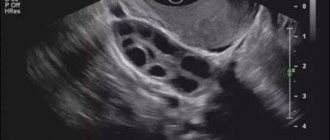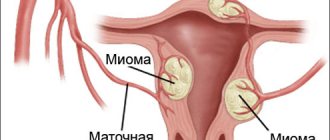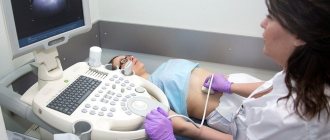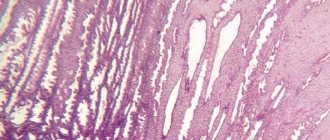In total, doctors distinguish two phases of the menstrual cycle. In each of them certain physiological changes occur. The final phase ends with the detachment of the endometrium and the beginning of menstruation. It is important to know the characteristics of the female body for girls who are planning a pregnancy or, conversely, are wary of it. The middle of the menstrual cycle is the most favorable period for conception. It is at this time that the egg leaves the ovary and is ready to meet the sperm. If fertilization does not occur, the endometrium will begin to peel off under the influence of certain hormones.
There are different phases of the menstrual cycle
What are the phases of the cycle?
It is customary to distinguish two phases of the cycle, but there is also a third - ovulation, which is the connecting link between the first two phases. Throughout the menstrual cycle, significant changes occur in the female body.
The main phases of the menstrual cycle are presented in the table.
| Follicular | This is the body’s preparatory stage for the upcoming ovulation. Starts from the first day of menstruation. The follicles and endometrium begin to enlarge under the influence of estrogen. There are no symptoms during this period. Vaginal discharge is clear and has a liquid consistency. Closer to ovulation, slight discomfort in the abdominal cavity may occur. |
| Ovulation | This is the shortest period. Is the peak of female fertility. On average, it begins on days 14-16, depending on the duration of menstruation. Characterized by the release of an egg from the ovary. The duration of ovulation varies from person to person. Usually it is 2-3 days. It is at this time that successful conception is possible. |
| Luteal | Considered the final phase. Ends with the beginning of menstruation if fertilization has not taken place. Progesterone production increases. The hormone peaks on day 22. |
The menstrual cycle is characterized by a clear cyclicity.
Duration of the menstrual cycle
The female cycle can have different lengths. Until a woman plans a pregnancy, she rarely pays attention to the length of this period. However, your menstrual cycle should always be closely monitored.
It is worth noting that the first day of the cycle is considered to be the day when bleeding from the genital tract began. The last day is the day before the start of a new female period.
What happens during the second phase
It is generally accepted that the luteal phase is the second. Ovulation lasts only a couple of hours or a day and is the so-called connecting link.
In the second phase, the formation of the corpus luteum occurs
The second phase of the cycle lasts up to 2 weeks, depending on individual characteristics. Characterized by the formation of the corpus luteum. All changes are activated thanks to the luteinizing hormone, which is produced by the pituitary gland.
The main responsibility of the corpus luteum is the production of progesterone. In this way, the body prepares for possible conception.
Progesterone produced in the second phase has the following effects:
- increases the sensitivity of the endometrium;
- relaxes the muscle layer of the uterus;
- activates uterine enlargement;
- supports the body's protective functions;
- promotes the deposition of subcutaneous fat;
- stops critical days upon successful fertilization.
If fertilization is successful, the corpus luteum is destroyed and hormones are produced by the placenta. If there is no pregnancy, then menstruation begins.
After conception, the corpus luteum is destroyed
How to extend the luteal phase
The luteal phase can be extended with the help of a properly formulated diet. Great importance is attributed primarily to vitamin B6. It can be found in peas, beans, meat, fish, nuts, potatoes and other starchy vegetables, as well as fruits such as bananas. Vitamin B6 is responsible for increasing progesterone concentrations and decreasing estrogen levels, which is especially important in the luteal phase.
An equally important vitamin for women with a short luteal phase is vitamin C. The right amount of this ingredient in the diet has been shown to balance hormone levels in the body, including progesterone. Where can we find the most vitamin C? Of course, in citrus fruits, but also in peppers, parsley, cranberries, broccoli and black currants.
Are you tired of irregular periods? Or maybe you've been trying to get pregnant for months without success? If this is the case, make an appointment with a specialist and find out whether the cause of infertility is a too short luteal phase.
MAKE AN APPOINTMENT
Abortion and contraception clinic in St. Petersburg - department of the medical gynecological association "Diana"
Make an appointment, tests or ultrasound via the contact form or by calling +8 (812) 62-962-77. We work seven days a week from 09:00 to 21:00.
We are located in the Krasnogvardeisky district, next to the Novocherkasskaya, Ploshchad Alexander Nevsky and Ladozhskaya metro stations.
The cost of a medical abortion in our clinic is 3,300 rubles. The price includes all pills, an examination by a gynecologist and an ultrasound to determine the timing of pregnancy.
Share link:
How does a woman feel in phase 2?
Due to hormonal fluctuations, changes in well-being occur during the second phase. The following symptoms appear:
- mood improves significantly;
- sexual desire increases;
- efficiency and mental potential increases.
All of these signs are present immediately after ovulation. Then, if fertilization does not take place, PMS symptoms occur.
The girl begins to complain about:
- weakness;
- increased sensitivity in the mammary gland;
- increased amount of vaginal discharge;
- rashes on the skin;
- headache;
- decreased performance;
- frequent mood changes;
- tearfulness;
- weight gain;
- swelling;
- increased appetite;
- drowsiness;
- discomfort in the lower abdomen.
Appetite often increases before menstruation.
Everything is individual. For some girls, PMS can be intense and cause significant discomfort, while for others, on the contrary, there are no obvious signs of a change in the condition.
PMS occurring in the second phase of the menstrual cycle should be accompanied by moderate discomfort. If the condition worsens significantly, consult a doctor to rule out possible pathological disorders.
First part of the cycle
This period is called the follicular phase. This name is generally accepted and better known. There are also the following names: follicular, proliferative period. This period of time lasts on average two weeks. But this value can range from one to three weeks. All this is normal and does not require medical intervention.
This period of time begins when menstruation begins. From this moment on, the pituitary gland produces follicle-stimulating hormone. It has a beneficial effect on the endometrium and helps the inner layer of the reproductive organ recover after menstrual bleeding. FSH also has a tremendous effect on the ovaries. In these organs, vesicles called follicles begin to grow. Around the middle of the cycle, one (rarely two or three) dominant vesicle is released, which will subsequently release the egg.
In the first phase of the female cycle, most hormones are examined. The material is collected from the third to the fifth day of this period.
It is worth noting that during this period changes occur not only inside the female body. A representative of the fair sex may note that the discharge from the genital tract is quite scanty and thick. Also at this time, basal temperature remains low. The average reading on the thermometer is from 36 to 36.5 degrees.
The phases of the menstrual cycle change precisely when ovulation occurs. During this period, the pituitary gland begins to actively produce luteinizing hormone. This substance affects the growing follicle, and the vesicle ruptures. It is from this second that the second phase of the menstrual cycle begins.
What is short phase 2
Diagnosed when a small amount of progesterone is produced. Considered a deficiency. The diagnosis is made when phase 2 lasts up to 10 days.
The reasons causing the violation include:
- disturbances in the functioning of organs that produce hormones;
- decreased sensitivity of the endometrium to hormonal changes;
- disturbances in metabolic processes;
- poor diet and nutritional deficiencies;
- blood flow disturbance;
- hereditary predisposition.
For all the features of the menstrual cycle, watch this video:
With such a violation, there is a low probability of carrying the child to full term. The deviation also leads to infertility. Only a doctor can make a diagnosis through a comprehensive examination.
The endometrium has a looser structure. The fertilized egg cannot attach normally. The body rejects it as something foreign. The condition requires complex drug treatment.
Violation of the duration of the female cycle
As mentioned earlier, the cycle can be long or short. Any deviation from the norm should be treated.
It is also worth noting that the female period should always be stable. The discrepancy in cycle duration should be no more than three days. For example, if a woman's period lasts 25 days, then this is normal. But if next month this period is 32 days, then this is already a deviation and a malfunction in the body.
Sometimes a disruption in the cycle can occur due to the formation of functional cysts. There's nothing wrong with that. Most often, such tumors resolve on their own. If this phenomenon occurs quite often, then the woman needs to examine the phases of the menstrual cycle. This can be done using a blood test. Laboratory technicians will determine the level of hormones in your body and give the result.
Long 2 phase
The pathology is diagnosed when the second phase lasts more than 10 days. Progesterone levels are off the charts. The condition is accompanied by symptoms that resemble pregnancy. Body temperature rises. Basal temperature is increased. The condition can cause disturbances in the functioning of the gastrointestinal tract. There is pain in the head.
A woman often thinks that she is pregnant, but this reason for the disorder can be refuted with the help of a test or ultrasound.
The reasons for extended phase 2 include:
- disruptions in the functioning of the adrenal glands;
- kidney disease;
- cystic formations.
The condition requires proper medical treatment. See your doctor.
If you have any alarming symptoms, contact your doctor immediately
Treatment of irregularities in the duration of the female cycle
Most often, hormonal drugs are chosen for correction.
If a woman is planning a pregnancy, she is prescribed medications to support the second phase. They also have a beneficial effect on hormones produced by the pituitary gland. Most often, doctors recommend Progesterone injections, Utrozhestan vaginal suppositories or Duphaston pills.
In the event that a representative of the fair sex does not plan to give birth in the near future, she may be recommended to take oral contraceptives. Depending on the results of the hormonal study, the doctor may prescribe the tablets “Diana-35”, “Logest”, “Novinet” and others. There are a great many such drugs nowadays. A competent specialist will choose what is right for you.
Prevention of violations
Yes, in some cases, if we are not talking about congenital pathologies, such cycle disruptions can be prevented. The methods are very simple and accessible to every woman. First of all, you need a good diet, including vegetable fats, moderate physical activity, and, in general, a healthy lifestyle.
Attentive attitude to women's health (prevention of infectious, inflammatory diseases of the genital organs), taking contraceptives only on the recommendation of a doctor, timely contact with specialists for various diseases - these are all things that will help to avoid problems with the menstrual cycle. Accordingly, with conception and pregnancy too.
httpss://www.youtube.com/watch?v=yZC0CjZURFg
First and second phase of the cycle
As you know, the first half of the cycle begins on the first day of menstruation and continues until ovulation. At this time, a follicle matures in the woman’s ovaries, from which the egg will be released, and the body as a whole prepares for a future pregnancy.
After the follicle matures, its walls burst and an egg emerges, heading towards the ampulla of the fallopian tube, where fertilization should occur. This moment is called ovulation. After it, the second phase of the cycle begins.
Disorders of the second phase of the cycle
As mentioned above, this half of the cycle lasts approximately 2 weeks and is characterized by high levels of progesterone in the woman’s body. However, with a number of disorders, progesterone levels may be reduced or, conversely, increased. In the first case they talk about a short second phase, in the second – about a long one. If we talk about the desired conception, both violations are critical. And for pregnancy, a more serious problem is the short second phase of the cycle.
Short luteal phase
The second name for this disorder is luteal phase deficiency (LPF), and it is caused by the fact that the corpus luteum, formed in the follicle, produces an insufficient amount of progesterone.
How long can the luteal phase last with this disorder? Doctors diagnose NLF when the second part of the cycle decreases to 10 days or less.
The reasons for this pathology can be different:
- disturbances in the functioning of the hypothalamus, pituitary gland or ovaries;
- decreased sensitivity of the endometrium to progesterone;
- metabolic disease;
- malnutrition;
- circulatory disorders;
- genetic, immune factors.
This disorder is manifested, first of all, by habitual miscarriage or long-term infertility. The diagnosis is confirmed after studying hormonal status, ultrasound, and endometrial biopsy.
Infertility and miscarriage occur due to the fact that with insufficient levels of progesterone, the endometrium in the uterus is less loose than required for successful implantation of the fertilized egg. A miscarriage occurs because the muscles of the uterus become toned, the immune system does not decrease, so the fertilized egg may be rejected as a foreign body.
Treatment should be comprehensive, aimed at restoring body functions. Hormone replacement therapy alone may not give the expected result.
Long luteal phase
How long can the second half of the cycle last with such a violation? The numbers vary, but if it lasts much more than two weeks, we can talk about pathology.
The long second phase is characterized by increased levels of progesterone. In this case, the manifestations of the disorder are similar to the signs of pregnancy - amenorrhea occurs or the cycle becomes too long, body weight increases, and basal temperature is also increased.
There may be disruption of the gastrointestinal tract, frequent headaches, sweating, increased greasiness of the skin, irritability and other symptoms characteristic of pregnancy, but the woman is not pregnant, as confirmed by tests and ultrasound.
Reasons for increased progesterone include:
- malfunction of the adrenal glands;
- bleeding in the uterus of various etiologies;
- renal failure;
- Corpus luteum cyst.
Of course, the long second phase of the menstrual cycle requires treatment, and not independent, but professional. To be successful, it is necessary to find out the cause of the problem and direct therapy to eliminate it. There are many different methods, and each specific case has its own treatment regimen.









